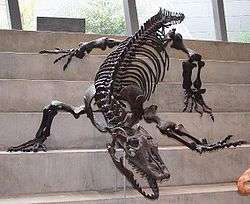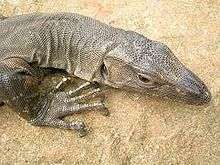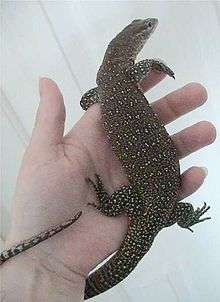Monitor lizard
| Monitor lizard Temporal range: Miocene to present | |
|---|---|
| | |
| Rock monitor (Varanus albigularis) | |
| Scientific classification | |
| Kingdom: | Animalia |
| Phylum: | Chordata |
| Class: | Reptilia |
| Order: | Squamata |
| Family: | Varanidae |
| Genus: | Varanus Merrem, 1820 |
| Type species | |
| Varanus varius Shaw, 1790 | |
| Subgenera | |
| |
Monitor lizard is the common name of several large lizard species, comprising the genus Varanus. They are native to Africa, Asia and Oceania, but are now found also in the Americas as an invasive species.
Monitor lizards have long necks, powerful tails and claws, and well-developed limbs. The adult length of extant species ranges from 20 cm (7.9 in) in some species, to over 3 m (10 ft) in the case of the Komodo dragon, though the extinct varanid known as megalania (Varanus priscus) may have been capable of reaching lengths of as much as 7 m (23 ft). Most monitor species are terrestrial, but arboreal and semiaquatic monitors are also known. While most monitor lizards are carnivorous, eating eggs, smaller reptiles, fish, birds and small mammals, some also eat fruit and vegetation, depending on where they live.[1]
A total of 78 species are currently recognized; however, given that several species-groups are in need of taxonomic review, this number is certain to be increased with future research.
Distribution
The various species cover a vast area, occurring through Africa, the Indian Subcontinent, to China, down Southeast Asia to Brunei, Indonesia, the Philippines, New Guinea, Australia and islands of the Indian Ocean, and the South China Sea. A large concentration of monitor lizards occurs on Tioman Island in the Malaysian state of Pahang. Some are now found in South Florida, particularly in the Everglades and Singapore.
Habits and diet
Monitors lizards are, as a rule, almost entirely carnivorous. However, three arboreal species, Varanus bitatawa, Varanus mabitang, and Varanus olivaceus, are primarily fruit eaters.[2][3]
Biology
The genus Varanus is considered unique among animals in that its members are relatively morphologically conservative and yet show a range in size that is equivalent to a mouse and an elephant.[4] Finer morphological features such as the shape of the skull and limbs do vary though, and are strongly related to the ecology of each species. [5][6]
Most monitor lizards are carnivorous.[7] Monitor lizards are infamous for their active nature, maintaining large territories and employing active pursuit hunting techniques that are reminiscent of similar sized mammals.[7] The active nature of monitor lizards has led to numerous studies on the metabolic capacities of these lizards. The general consensus is that monitor lizards have the highest standard metabolic rates of all extant reptiles.[8]
Monitor lizards have a high aerobic scope[8][9] that is afforded, in part, by their heart anatomy. Whereas most reptiles are considered to have three chambered hearts, the hearts of monitor lizards — as with those of boas and pythons — have a well developed ventricular septum that completely separates the pulmonary and systemic sides of the circulatory system during systole.[10] This allows monitor lizards to create mammalian-equivalent pressure differentials between the pulmonary and systemic circuits,[10] which in turn ensures that oxygenated blood is quickly distributed to the body without also flooding the lungs with high pressure blood.
Anatomical and molecular studies indicate that all varanids (and possibly all lizards) are partially venomous.[11][12] Monitor lizards are oviparous,[8] laying from seven to 37 eggs, which they often cover with soil or protect in a hollow tree stump.
Evolution

During the late Cretaceous era, monitor lizards or their close relatives are believed to have evolved into amphibious and then fully marine forms, the mosasaurs, which reached lengths of up to 17 m (56 ft).
Snakes were believed to be more closely related to monitor lizards than any other type of extant reptile; however, it has been more recently proposed that snakes are the sister group of the clade of iguanians and anguimorphs.[12] Like snakes, monitor lizards have forked tongues which they use to sense odors.[13]
During the Pleistocene epoch, giant monitor lizards lived in Southeast Asia and Australasia, the best known fossil being the megalania (Varanus priscus, a giant goanna formally known as Megalania prisca). This species is an iconic member of the Pleistocene megafauna of Australia, thought to have survived up until around 50,000 years ago.[14]
Some monitor lizards, including the Komodo dragon, are capable of parthenogenesis.[15]
Etymology
The generic name Varanus is derived from the Arabic word waral ورل, (alternative word waran). The name comes from a common Semitic root ouran, waran, or waral, meaning "dragon" or "lizard beast".[16] The occasional habit of varanids to stand on their two hind legs and to appear to "monitor" their surroundings has been suggested to have led to this name, as it was Latinized into Varanus. Its common name is derived from the Latin word monere meaning "to warn".[16]
In Austronesia, where varanids are common, they are known under a large number of local names. They are usually known as biawak (Malay and Indonesian), bayawak (Filipino), binjawak or minjawak (Javanese), or variations thereof. Other names include hokai (Solomon Islands), bwo or puo (Maluku), halo (Cebu), galuf of kaluf (Micronesia and the Caroline Islands), batua or butaan (Luzon), alu (Bali), hora or ghora (Komodo group of islands), phut (Burmese) and guibang (Manobo).[17][18]
In Tamil and Malayalam, monitor lizards are known as udumbu, ghorpad घोरपड in Marathi, uda in Kannada, in Sinhalese as kabaragoya, in Telugu as udumu, in Punjabi and Magahi (and other Bihari languages) as गोह (goh), in Assamese as gui xaap, and in Odia as ଗୋଧି (godhi), and in Bengali as গোসাপ (goshaap) or গুইসাপ (guishaap) and गोह (goh) in Hindi. Due to confusion with the large New World lizards of the family Iguanidae, the lizards became known as "goannas" in Australia. Similarly, in South Africa, they are referred to as leguaan, or likkewaan from the Dutch for iguana. The generic name inspired the name of the Japanese movie monster Varan.
Intelligence
Varanid lizards are very intelligent, and some species can even count.[19] Careful studies feeding V. albigularis at the San Diego Zoo varying numbers of snails showed that they can distinguish numbers up to six.[19][20] V. niloticus lizards have been observed to cooperate when foraging.[19] One varanid lures the female crocodile away from her nest, while the other opens the nest to feed on the eggs.[19] The decoy then returns to also feed on the eggs.[19][20] Komodo dragons, V. komodoensis, at the National Zoo in Washington, D.C., recognize their keepers and seem to have distinct personalities.[20]
Uses
As pets
Monitor lizards have become a staple in the reptile pet trade. The most commonly kept monitors are the savannah monitor and Ackies monitor, due to their relatively small size, low cost, and relatively calm dispositions with regular handling.[16] Among others, black-throated monitors, timor monitors, Asian water monitors, Nile monitors, mangrove monitors, emerald tree monitors, black tree monitors, roughneck monitors, dumeril's monitors, peach-throated monitors, crocodile monitors and Argus monitors have been kept in captivity.[16] Like all reptiles kept as pets, monitors need an appropriately sized enclosure, hiding places, and an appropriate substrate.[16] They will not share their enclosure with another large animal. Some water monitors also need a large water dish in which they can soak their entire bodies.[16] In the wild, monitors will eat anything they can overpower, but crickets, superworms, feeder fish, and the occasional rodent (for calcium) make up most of the smaller captive monitors' diets. Boiled eggs, silkworms, and earthworms can also be fed to them.[16] Larger species, such as Nile monitors, Asian water monitors, crocodile monitors, perenties, and Argus monitors, will eventually require larger prey. Paleontologist and biology professor at Temple University, Michael Balsai has observed V. prasinus eating fruit in captivity, as has herpetologist and author, Robert G. Sprackland.[16][21]
Medicinal
Monitor lizard meat, particularly the tongue and liver, is eaten in parts of southern India and Malaysia as an alleged aphrodisiac.[22][23]
In parts of Pakistan, different parts of monitor lizards are used for a variety of medical purposes. The flesh is eaten for the relief of rheumatic pain, abdominal fat is used as a salve for skin infections, oil and fat are used to treat hemorrhoids or chronic pain, and the oil is used as an aphrodesiac lubricant (saande kaa tel).[24]
Leather
"Large scale exploitation" of monitor lizards is undertaken for their skins, which are described as being "of considerable utility" in the leather industry.[24]
Food
The meat of monitor lizards is eaten by some tribes in India, Thailand and in West Africa as a supplemental meat source.
Occult
The reproductive organs of monitor lizards are used in "black magic" in parts of Pakistan.[24]
Music
The skin of monitor lizards is used in making a "Carnatic Music" instrument called "Kanjira",which is a percussion instrument.
Protected status
All but five species of monitor lizard are classified by the Convention on International Trade in Endangered Species of Wild Fauna and Flora under Appendix II, which is loosely defined as species that are not necessarily threatened with extinction, but may become so unless trade in such species is subject to strict regulation order to avoid use incompatible with the survival of the species in the wild. The remaining five species - V. bengalensis, V. flavescens, V. griseus, V. komodoensis, and V. nebulosus - are classified under CITES Appendix I, which outlaws international commercial trade in the species.[25]
In Tamil Nadu and all other parts of South India, catching or killing of monitor lizards is banned under the Protected Species Act.
Classification





Genus Varanus
- Species marked with † are extinct
Subgenus Empagusia:
- V. bengalensis, Bengal monitor
- V. dumerilii, Dumeril's monitor
- V. flavescens, golden monitor, yellow monitor, short-toed monitor
- V. nebulosus, clouded monitor
- V. rudicollis, roughneck monitor
Subgenus Euprepiosaurus:
- V. beccarii, black tree monitor
- V. boehmei, golden-spotted tree monitor
- V. caerulivirens, turquoise monitor
- V. cerambonensis, Ceram monitor
- V. doreanus, blue-tailed monitor
- V. finschi, Finsch's monitor
- V. indicus, mangrove monitor
- V. jobiensis, peach-throated monitor
- V. juxtindicus, Rennell Island monitor
- V. keithhornei, canopy goanna, blue-nosed tree monitor, Nesbit River monitor[26]
- V. kordensis, Biak tree monitor
- V. macraei, blue-spotted tree monitor

- V. melinus, quince monitor[27]
- V. lirungensis, Talaud mangrove monitor
- V. obor, sago monitor
- V. prasinus, emerald tree monitor[28]
- V. rainerguentheri Rainer Günther’s monitor
- V. spinulosus, Spiny-necked mangrove monitor, Solomon Islands spiny monitor
- V. telenesetes, mysterious tree monitor, Rossell tree monitor
- V. zugorum, silver monitor, Zug's monitor
Subgenus Odatria:
- V. acanthurus, ridge-tailed monitor
- V. a. acanthurus, ridge-tailed monitor
- V. a. brachyurus, common ridge-tailed monitor
- V. a. insulanicus, island ridge-tailed monitor
- V. auffenbergi, Auffenberg's monitor, peacock monitor
- V. baritji, White's dwarf monitor, black-spotted ridge-tailed monitor, lemon-throated monitor[29]
- V. brevicauda, short-tailed monitor
- V. bushi, Pilbara stripe-tailed monitor, Bush's monitor
- V. caudolineatus, stripe-tailed monitor
- V. eremius, rusty desert monitor, pygmy desert monitor
- V. gilleni, pygmy mulga monitor
- V. glauerti, Kimberley rock monitor
- V. glebopalma, twilight monitor, black-palmed rock monitor
- V. hamersleyensis, Hamersley Range rock monitor
- V. kingorum, Kings' rock monitor
- V. mitchelli, Mitchell's water monitor
- V. sparnus, Dampier Peninsula monitor
- V. storri, Storr's monitor
- V. s. storri, eastern Storr's monitor
- V. s. ocreatus, western Storr's monitor
- V. timorensis, Timor monitor
- V. tristis, black-headed monitor
- V. t. orientalis, freckled monitor
Subgenus Papusaurus:
- V. salvadorii, crocodile monitor
Subgenus Philippinosaurus:
- V. bitatawa, Northern Sierra Madre forest monitor, butikaw, bitatawa
- V. mabitang, Panay monitor, mabitang
- V. olivaceus, Gray's monitor, butaan
Subgenus Polydaedalus:
- V. albigularis, rock monitor, white-throated monitor
- V. a. albigularis, white-throated monitor
- V. a. angolensis, Angolan monitor
- V. a. microstictus, eastern white-throated monitor
- V. exanthematicus, savanna monitor, Bosc's monitor
- V. niloticus, Nile monitor
- V. ornatus, ornate monitor
- V. stellatus, West African Nile monitor
Subgenus Psammosaurus:
- V. griseus, desert monitor
- V. g. griseus, desert monitor, grey monitor
- V. g. caspius, Caspian monitor
- V. g. koniecznyi, Indian desert monitor, Thar desert monitor
- V. nesterovi, Zagros monitor
Subgenus Soterosaurus:
- V. cumingi, Cuming's water monitor, yellow-headed water monitor
- V. marmoratus, marbled water monitor, Philippine water monitor
- V. palawanensis Palawan water monitor
- V. salvator, Asian water monitor
- V. s. salvator, Sri Lankan water monitor
- V. s. andamanensis, Andaman water monitor
- V. s. bivittatus, Two-striped water monitor, Javan water monitor
- V. s. macromaculatus, Southeast Asian water monitor
- V. s. ziegleri, Ziegler's water monitor
Subgenus †Varaneades:
- †V. amnhophilis, Samos dragon
Subgenus Varanus:
- V. giganteus, perentie
- V. gouldii, sand monitor, Gould's monitor
- V. komodoensis, Komodo dragon
- V. mertensi, Mertens' monitor
- V. panoptes
- V. p. panoptes, argus monitor
- V. p. horni, Horn's monitor
- V. p. rubidus, yellow-spotted monitor
- †V. priscus, megalania (extinct)
- V. rosenbergi, Rosenberg's monitor, heath monitor
- V. spenceri, Spencer's monitor
- V. varius, lace monitor
References
- ↑ Bauer, Aaron M. (1998). Cogger, H.G. & Zweifel, R.G., ed. Encyclopedia of Reptiles and Amphibians. San Diego: Academic Press. pp. 157–159. ISBN 0-12-178560-2.
- ↑ Greene, Harry W. (1986). Diet and Arboreality in the Emerald Monitor, Varanus Prasinus, with Comments on the Study of Adaptation. Chicago: Field Museum of Natural History. OCLC 14915452. Retrieved 12 December 2013.
- ↑ Welton, L. J.; Siler, C. D.; Bennett, D.; Diesmos, A.; Duya, M. R.; Dugay, R.; Rico, E. L. B.; Van Weerd, M.; Brown, R. M. (2010). "A spectacular new Philippine monitor lizard reveals a hidden biogeographic boundary and a novel flagship species for conservation". Biology Letters 6 (5): 654–658. doi:10.1098/rsbl.2010.0119. ISSN 1744-9561. PMC 2936141. PMID 20375042.
- ↑ Pianka, E.R. (1995). Evolution of Body Size: Varanid Lizards as a Model System. Am. Nat. 146(3):398–414.
- ↑ http://journals.plos.org/plosone/article?id=10.1371/journal.pone.0130625
- ↑ http://onlinelibrary.wiley.com/doi/10.1111/j.1469-7998.2009.00559.x/pdf
- 1 2 King, D., Green, B., Knight, F. (1999). Monitors: The Biology of Varanid Lizards. Florida. Krieger Publishing Company.
- 1 2 3 Pianka, E.R., Vitt, L.J. (2003). Lizards: Windows to the Evolution of Diversity. California. University of California Press.
- ↑ Wood, S.C., Johansen, K., Glass, M.L., Maloiy, G.M.O. (1978). Aerobic Metabolism of the Lizard Varanus exanthematicus: Effects of Activity, Temperature, and Size. J. Comp. Physiol. 127:331–336.
- 1 2 Wang, T., Altimiras, J., Klein, W., Axelsson, M. (2003). Ventricular Haemodynamics in Python molurus: Separation of Pulmonary and Systemic Pressures. J. Exp. Biol. 206(23):4242–4245.
- ↑ Fry, B.G.; Wroe, S; Teeuwisse, W; van Osch, JP; Moreno, K; Ingle, J; McHenry, C; Ferrara, T; Clausen, P; Scheib, H; Winter, KL; Greisman, L; Roelants, K; van der Weerd, L; Clemente, CJ; Giannakis, E; Hodgson, WC; Luz, S; Martelli, P; Krishnasamy, K; Kochva, E; Kwok, HF; Scanlon, D; Karas, J; Citron, DM; Goldstein, EJC; Mcnaughtan, JE; Norman JA. (June 2009). "A central role for venom in predation by Varanus komodoensis (Komodo dragon) and the extinct giant Varanus (Megalania) priscus.". PNAS 106 (22): 8969–8974. doi:10.1073/pnas.0810883106. PMC 2690028. PMID 19451641. Cite uses deprecated parameter
|coauthors=(help) - 1 2 Fry, B.G.; Vidal, N; Norman J.A.; Vonk F.J.; Scheib, H.; Ramjan S.F.R; Kuruppu S.; Fung, K.; Hedges, B.; Richardson M.K.; Hodgson, W.C.; Ignjatovic, V.; Summerhays, R.; Kochva, E. (February 2006). "Early evolution of the venom system in lizards and snakes" (PDF). Nature 439 (7076): 584–588. doi:10.1038/nature04328. PMID 16292255. Cite uses deprecated parameter
|coauthors=(help) - ↑ "Monitor Lizards". BBC Nature. BBC. Retrieved 2014-03-05. External link in
|work=(help) - ↑ Price, Gilbert J.; Louys, Julien; Cramb, Jonathan; Feng, Yue-xing; Zhao, Jian-xin; Hocknull, Scott A.; Webb, Gregory E.; Nguyen, Ai Duc; Joannes-Boyau, Renaud (2015-10-01). "Temporal overlap of humans and giant lizards (Varanidae; Squamata) in Pleistocene Australia". Quaternary Science Reviews 125: 98–105. doi:10.1016/j.quascirev.2015.08.013.
- ↑ Smith, Kerri. "Dragon virgin births startle zoo keepers". Nature. Retrieved 2006-12-20.
- 1 2 3 4 5 6 7 8 Robert George Sprackland (1992). Giant lizards. Neptune, NJ: T.F.H. Publications. p. 61. ISBN 0-86622-634-6.
- ↑ Mark K. Bayless (2004). "The local names of Pacific monitor lizards (Sauria: Varanidae) of Oceania & Indo-Malaysia, excluding Australia" (PDF). Micronesia 37 (1): 49–55.
- ↑ Maren Gaulke (1992). "Taxonomy and biology of Philippine water monitors (Varanus salvator)" (PDF). The Philippine Journal of Science 121 (4): 345–381.
- 1 2 3 4 5 King, Dennis & Green, Brian. 1999. Goannas: The Biology of Varanid Lizards. University of New South Wales Press. ISBN 0-86840-456-X, p. 43.
- 1 2 3 Pianka, E.R.; King, D.R. and King, R.A. (2004). Varanoid Lizards of the World. Indiana University Press.
- ↑ Balsai, Michael (1997). The General Care and Maintenance of Popular Monitors and Tegus. BowTie. p. 6. ISBN 978-1-882770-39-7.
- ↑ Parameswaran, K (2006). "Case series of eosinophilic meningoencephalitis from South India". Annals of Indian Academy of Neurology 9 (4): 217–222. doi:10.4103/0972-2327.29203. ISSN 0972-2327. Retrieved 12 December 2013.
- ↑ http://themalaysianlife.blogspot.com/2009/04/eating-biawak.html
- 1 2 3 Hashmi, M. Usman Ali; Khan, M. Zaheer; Amtyaz; Huda, Nawaz Ul. "Current Status, Distribution and Threats of Varanus Species (Varanus bengalensis & Varanus griseus) in Karachi & Thatta of Sindh" (PDF). International Journal of Fauna and Biological Studies (AkiNik Publications) 1 (1): 34–38. ISSN 2347-2677. Retrieved 12 December 2013.
- ↑ "Identification Guides for Wildlife Traded in Southeast Asia". ASEAN-WEN. 2008.
- ↑ Varanus keithhornei, The Reptile Database
- ↑ Mappress.com
- ↑ Varanus prasinus, The Reptile Database
- ↑ Varanus baritji, The Reptile Database
External links
| Wikispecies has information related to: Varanidae |
| Wikimedia Commons has media related to Varanidae. |
| ||||||||||||||||||||||||||||||||||||||||||||||
|

